
Digital Literacies
Routledge (Verlag)
978-1-032-20163-4 (ISBN)
Dramatic shifts in our communication landscape have made it crucial for language teaching to go beyond print literacy and encompass the digital literacies which are increasingly central to learners' personal, social, educational and professional lives. By situating these digital literacies within a clear theoretical framework, this book provides educators and students alike with not just the background for a deeper understanding of these key 21st-century skills, but also the rationale for integrating these skills into classroom practice. This is the first methodology book to address not just why but also how to teach digital literacies in the English language classroom. This book provides:
A theoretical framework through which to categorise and prioritise digital literacies
Practical classroom activities to help learners and teachers develop digital literacies in tandem with key language skills
A thorough analysis of the pedagogical implications of developing digital literacies in teaching practice
A consideration of exactly how to integrate digital literacies into the English language syllabus
Suggestions for teachers on how to continue their own professional development through PLNs (Personal Learning Networks), and how to access teacher development opportunities online.
This book is ideal for English language teachers, English language learners of all ages and levels, academics and researchers of all age groups and levels, academics and students researching digital literacies, and anyone looking to expand their understanding of digital literacies within a teaching framework.
Mark Pegrum is an Associate Professor of Education at the University of Western Australia. Nicky Hockly is Co-Director, and Director of Pedagogy, at The Consultants-E, an online training and development consultancy specialising in the application of technology to the language classroom, and online teacher training. Gavin Dudeney is Co-Director, and Director of Technology, at The Consultants-E.
Contents
Preface xi
Acknowledgements xiv
I: From research to implications 1
Diverse literacies for a superdiverse era 2
The Framework of Digital Literacies 3.0 5
Box I.1 What hardware, software & connectivity do we need? 6
First focus: Communicating 11
Print literacy 12
Texting (& reconstructive) literacy 13
Box I.2 What happened to our digital natives? 14
Hypertext literacy 16
Multimodal literacy 16
Box I.3 Do social media belong in our classrooms? 18
Immersive (and gaming/XR) literacy 20
Spatial literacy 21
Mobile literacy 22
Box I.4 Does the digital divide still matter? 22
Code (& technological/AI) literacy 25
Second focus: Informing 27
Tagging (and hashtag) literacy 27
Search literacy 29
Box I.5 Can we trust Wikipedia? 30
Filtering literacy 31
Information (and data) literacy 32
Box I.6 How should we deal with fake news? 32
Third focus: Collaborating 36
Personal (and security) literacy 36
Box I.7 How can we protect our students (and ourselves) online? 37
Network literacy 39
Box I.8 Why do our students need personal learning networks? 39
Participatory literacy 41
Box I.9 How much should we worry about censorship and surveillance? 42
Intercultural literacy 45
Ethical literacy 47
Fourth focus: (Re)designing 48
Attentional literacy 49
Box I.10 Does multitasking work? 50
Critical (and critical mobile/material/philosophical/academic) literacy 51
Box I.11 What do digital technologies mean for people and the planet? 53
Remix literacy 55
Box I.12 How do we deal with copyright and plagiarism? 57
Looking ahead 58
Further reading 59
II: From implications to application 60
Box II.1 Will digital technologies improve our students’ learning? 60
Box II.2 What if we have to teach language classes fully online? 62
The TPACK framework for integrating technology use 64
Box II.3 Who’s afraid of teaching with edtech? 65
The SAMR model for improving technology use 67
The T3 framework for extending technology use 68
Design justice 70
The Digital Activities Grid 72
The Digital Tools Grid 84
The Digital Risks Grid 84
45 Activities 92
Activity 1. Technology past & present 93
Activity 2. Becoming digitally literate 97
Activity 3. Writing the news 100
Activity 4. Extreme weather 103
Activity 5. Cryptic messages 110
Activity 6. Sports linking 114
Activity 7. Building links 119
Activity 8. Food boards 121
Activity 9. Copycat 124
Activity 10. Envisioning the facts 128
Activity 11. Sales techniques 131
Activity 12. Showcasing hobbies 135
Activity 13. Selling English 138
Activity 14. Avatars 141
Activity 15. Peeling back history 145
Activity 16. Spaced out 149
Activity 17. A picture a day 152
Activity 18. Mobile rules 155
Activity 19. This is us 159
Activity 20. Living on the edge 163
Activity 21. My digital assistant 166
Activity 22. Travel clouds 170
Activity 23. Hashtag activism 173
Activity 24. Search race 176
Activity 25. Search me 182
Activity 26. News in my networks 187
Activity 27. Digital social circles 191
Activity 28. Tree octopus 195
Activity 29. Fun facts 200
Activity 30. Faking it 203
Activity 31. Tracking personal wellness 208
Activity 32. Footprints in the wires 213
Activity 33. Setting the scene 215
Activity 34. Going viral 219
Activity 35. A class PLN 223
Activity 36. Our city guide 226
Activity 37. Pictorial vocab bank 230
Activity 38. Questioning stereotypes 233
Activity 39. Sign me up 237
Activity 40. Turn off, tune out 242
Activity 41. Ever mindful 245
Activity 42. An ethical phone? 250
Activity 43. Our digital planet 253
Activity 44. Keep calm and carry on learning English 258
Activity 45. Said no student ever 262
Future learning 265
III: From application to implementation 266
Incorporating activities into the syllabus 266
The coursebook-driven approach 269
The topic-driven approach 271
The digital literacies-driven approach 271
Choosing activities for different levels and contexts 272
Students’ linguistic competence 273
Students’ technological competence 274
Teachers’ technological competence 275
Overall complexity 276
Contexts 276
Teaching in technology-limited environments 279
Assessing digital work 280
A digital assessment matrix 281
Assessing through e-portfolios 282
IV: From implementation to research 285
Conducting and sharing action research and design-based research 285
Building and maintaining personal learning networks 287
Choosing platforms for personal learning networks 289
Twitter 289
Facebook 290
Other social media 290
Blogs 290
Working across platforms 291
Further reading 292
References 293
Activity keys 316
| Erscheinungsdatum | 27.04.2022 |
|---|---|
| Reihe/Serie | Research and Resources in Language Teaching |
| Zusatzinfo | 209 Tables, black and white; 10 Line drawings, black and white; 19 Halftones, black and white; 29 Illustrations, black and white |
| Verlagsort | London |
| Sprache | englisch |
| Maße | 152 x 229 mm |
| Gewicht | 560 g |
| Themenwelt | Schulbuch / Wörterbuch ► Wörterbuch / Fremdsprachen |
| Geisteswissenschaften ► Sprach- / Literaturwissenschaft ► Sprachwissenschaft | |
| Sozialwissenschaften ► Kommunikation / Medien ► Medienwissenschaft | |
| ISBN-10 | 1-032-20163-0 / 1032201630 |
| ISBN-13 | 978-1-032-20163-4 / 9781032201634 |
| Zustand | Neuware |
| Informationen gemäß Produktsicherheitsverordnung (GPSR) | |
| Haben Sie eine Frage zum Produkt? |
aus dem Bereich


